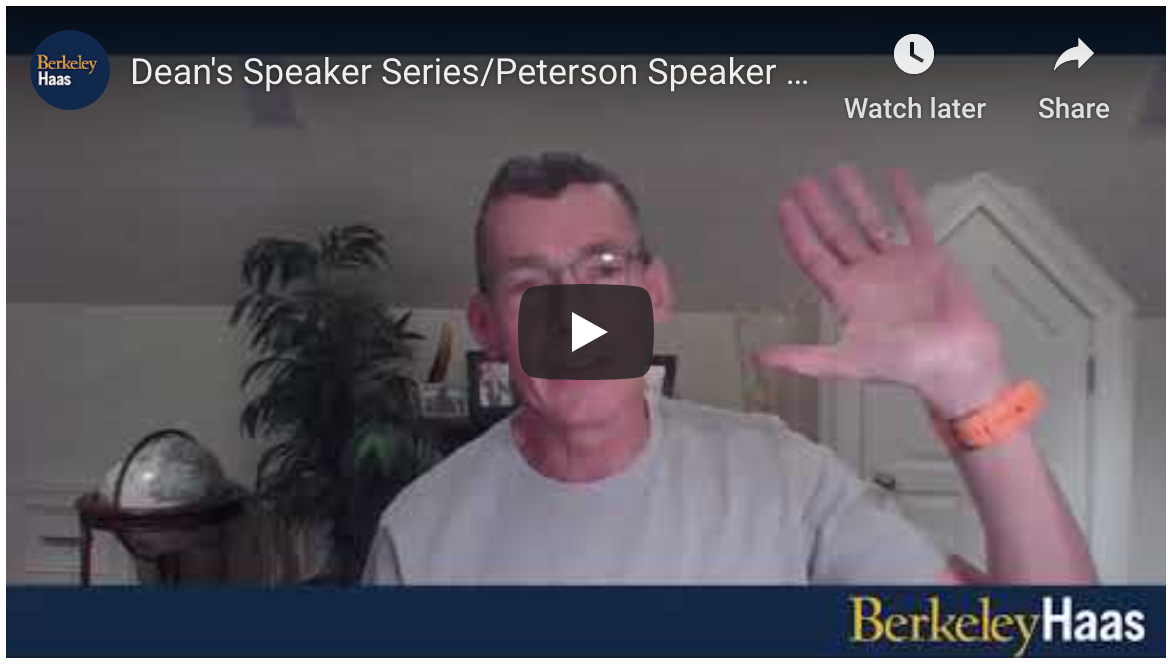Corporate Sustainability & Moving Towards Materiality: Lessons from the Peterson Speaker Series

by Shanna Hoversten, MBA/MPH ’16
“When I started working in this area we probably would have needed just a few seats at a coffee table to have this conversation – certainly not this entire room,” remarked George Serafeim, Associate Professor at Harvard Business School and Senior Partner at KKS Advisors, during last week’s Peterson Speaker Series on Corporate Sustainability and Materiality: Strategy, Practice, and Implementation. According to Serafeim, in the not-so-distant past there was a lot of skepticism around introducing sustainability metrics into investment decisions; but those critics are being proven wrong. Listening to Serafeim, the other panelists – Divya Mankikar, the head of ESG integration at CalPERS and Susanne Stormer, Novo Nordisk’s VP of Corporate Sustainability – and moderator Dan Hanson, Professor of the Berkeley-Haas Center for Responsible Business course: Haas Socially Responsible Investment Fund, it becomes clear that sustainability is not just a buzzword being thrown around in annual reports – leading companies and investment funds are now making sustainability a strategic priority.
Over the course of the 90-minute discussion, the panelists introduced numerous ideas and insights as to how companies and investment funds can implement corporate sustainability in strategic and material ways. I’ll pass along just a few of the critical lessons here:
- Strategic is the operative word in making Environmental, Social & Governance (ESG) initiatives work. As our panelists explained time and again, focus is critical when implementing sustainability initiatives within a company. Stormer noted that all too often, ESG metrics become a synonym for everything that is not financial and too often companies take the ‘kitchen sink’ approach to looking at these things. At Novo Nordisk, they started by asking: “what does it mean to be sustainable?” For their company, it meant continuing to be around in the future for the patients within the communities they serve. With this context set, Stormer and her team could better focus on the sustainability metrics that mattered. In other words, Novo Nordisk focused on the metrics that mattered most, and as Serafeim reiterated: “well-run organizations are focused organizations.”
- Contemporary investment beliefs are changing to make way for ESG. Mankikar explained how after the financial crisis, CalPERS began to think more comprehensively about their assumptions around risk. The result was a new set of investment beliefs: (1) that value creation beyond traditional means requires attention to not only financial capital, but natural and human capital as well, and (2) that risk is not fully expressed in traditional metrics like volatility, and this is where ESG metrics can add a lot of value.
- Measuring ESG can require some creativity. As Stormer explained, Novo Nordisk wanted to know how well they were doing in terms of reaching patients with their medications. While measuring pharmaceutical volumes is easy, measuring the number of lives impacted is not. Stormer and her team worked across the organization to come up with a proxy to measure this and published the metric in the company’s annual report. Though Stormer faced some initial criticism for reporting what was “just an estimate,” the organization later discovered the value of this benchmark; Novo Nordisk could now set yearly targets for improved patient reach, thereby amplifying their impact in a more precise way.
- How do you judge the authenticity of a company’s sustainability efforts? This can be a tricky task even for experts in the field; as Serafeim noted: “almost all companies will say they are the most sustainable company in the world; you go to some oil & gas company websites and if you didn’t know better you would think they were the WWF.” But in this era of ‘good-washing,’ Serafeim has come up with a test to judge authenticity: go to the CFO. Any sustainability effort that is authentic must have financial resources behind it, so if the CFO does not know about the initiative, that is pretty telling of its importance within the organization. Mankikar added that she judges authenticity by talking to the Board of Directors. In her experience, an initiative is authentic if: (1) a company is willing to make their Board available to talk about sustainability, and (2) if the Board is conversant on the topic.
One of the biggest takeaways from the panel was that this is an area of tremendous opportunity in the future. As Hanson commented, investments in ESG are not simply a fad; while we can all think of some ‘fluffy’ sustainability initiatives, more and more we are seeing initiatives with true materiality. This is good news for Haas students – as Mankikar explained, companies are looking for people who can speak the language of finance while also bringing the context of ESG issues. With this in mind, the Berkeley-Haas Center for Responsible Business hopes to provide Haas students with the resources to continue driving this shift in thinking about corporate sustainability and to help them deliver value to their companies through the material use of ESG.
To view the entire panel, please watch here.
The Peterson Speaker Series
The Peterson Series is the Center for Responsible Business’ flagship speaker series, established in 1997 by a generous gift from 1925 UC Berkeley graduate Rudolph Peterson. It convenes Berkeley-Haas MBA students, forward-thinking academics, and distinguished business leaders to discuss and illuminate topics related to sustainable and responsible business. Speakers and attendees have the chance to engage in focused discussion with potential partners and colleagues, while sharing and getting thoughtful feedback about their company’s practices.


